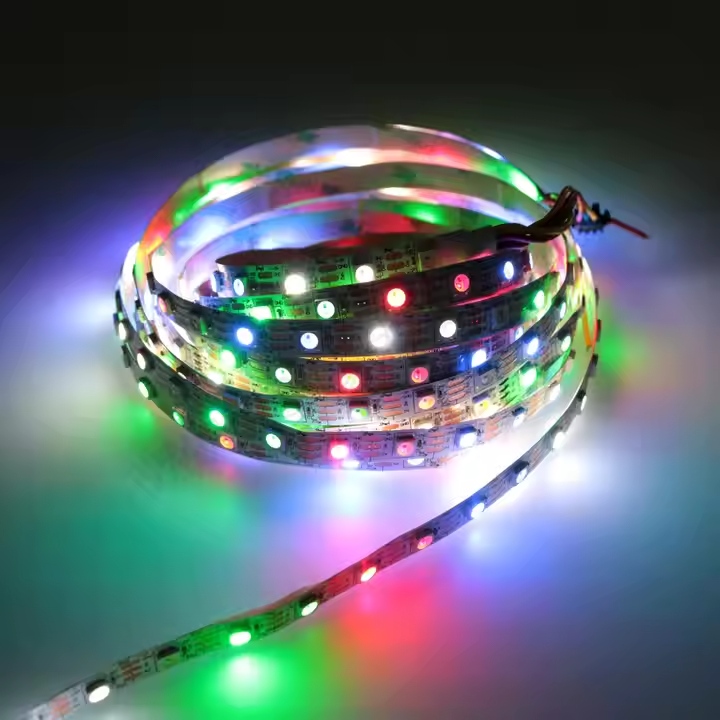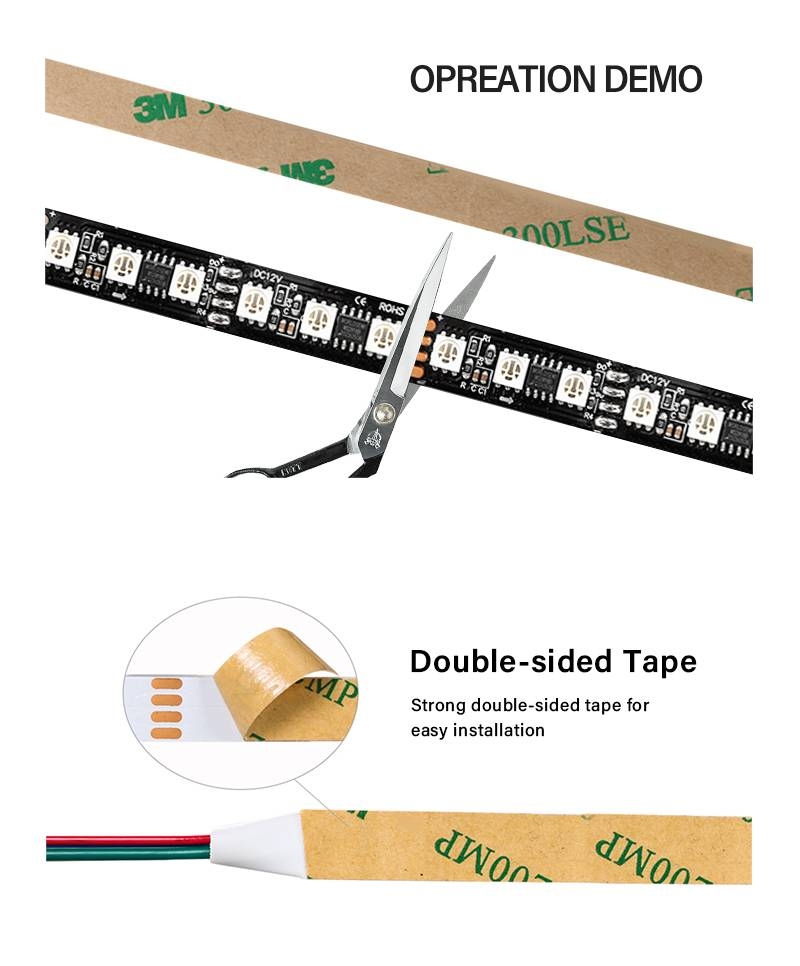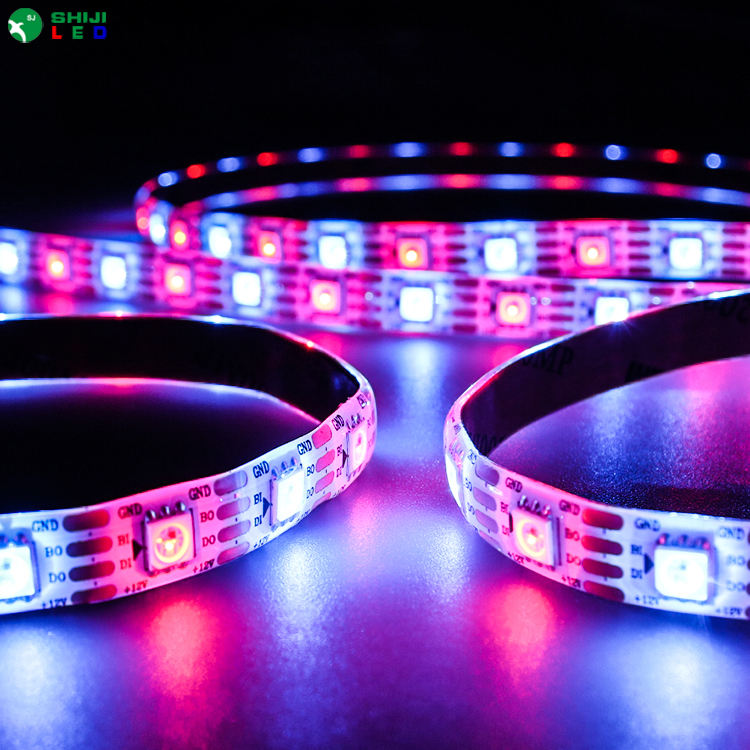Why Choose an Addressable LED Strip for Your Lighting Project?
What Makes Addressable LED Strips Different from Regular LED Strips?
Addressable LED strips bring a whole new level of pizzazz. Unlike regular strips where every LED glows the same color, these let you control each light or group on its own. You can whip up cool effects like chasing lights, soft fades, or rainbow waves.
Each strip has 1pcs LED pixel & 1 IC. IC chips like UCS1903, WS2811, WS2801, IPD6803, or SM16716 give every light node its own brain. This means you can program precise animations and color shifts to match your vibe.
How Do Addressable LED Strips Enhance Lighting Flexibility and Control?
Addressable LED strips are like magic wands for lighting. They offer tons of programmable effects and real-time tweaks. Whether you’re sprucing up your home or building a flashy commercial display, these strips bend to your vision.
They support numerous color-changing effects like running water, scanning, or blinking. Chips like GS8208 or SK6812, with dual-signal transmission, keep the show going even if one pixel flops, unless two next-door LEDs break.
Which Applications Benefit Most from Addressable LED Strip Integration?
These strips are super versatile and shine in all sorts of spots:
- Residential: Add cozy glows under cabinets or in living rooms with full pixel control.
- Commercial: Create eye-popping displays for shops or stage lights.
- Architectural: Jazz up buildings with neon or rigid bar setups.
You can set them to any color or animate with effects like running water, chasing, or flashing. They’re perfect for both practical lighting and fancy decor.
How to Compare Addressable LED Strip Specifications Effectively?
What Are the Key Technical Parameters to Examine?
Picking the right addressable LED strip means digging into a few key specs that shape how they perform.
Voltage Options and Power Consumption
Voltage is a biggie for matching power supplies and controllers. You’ll see options like 5V (SK6812), 12V (GS8208), or 24V models. Low voltage 12VDC input is common, but don’t go over 13V, or you might toast the whole strip. Higher voltages, like 24V, help with long runs to cut voltage drop.

IC Type and Pixel Density
The IC chip type matters for signal strength and features. For example, the GS8208 IC has two data signals / 2 data pins, so one pixel failing won’t stop the show unless two side-by-side LEDs go kaput. SK6812 gives RGBW output with a 120-degree beam angle for a brighter spread.
Pixel density, like 60 LEDs/m, affects how smooth animations look. More LEDs per meter mean slicker visuals.
Waterproof Rating and Durability
Waterproofing is key for outdoor or damp spots. Ratings go from IP20 (no water protection) to IP68 (dunk-proof). For tough setups, check out 14.5mm width and 4mm thickness for the waterproof IP67 + aluminum case + epoxy glue + clips & screws. Pick based on where they’ll live.
How Does Energy Efficiency Vary Between Different Models?
Power Saving Benefits in Long-Term Use
Energy efficiency saves you cash over time. Low-voltage systems like DC5V sip less power per meter but might need extra power injections for long runs due to voltage drop.
Impact of Strip Design on Energy Consumption
The strip’s design, like PCB width or layout, affects heat and energy loss. A 10mm/12mm width PCB, 0.25mm thickness, with 3M tape on the back side, keeps things cool while staying bendy.
What Installation Factors Should You Consider Before Buying?

How Easy Is It to Install an Addressable LED Strip?
Installing these strips is a breeze if you plan right. Flexible PCB designs let you curve around corners, and adhesive backing makes sticking them to flat surfaces super simple.
Mounting Methods for Various Surfaces
You’ve got options: adhesive tape for smooth indoor spots, silicone clips with screws for wet or outdoor areas, or aluminum channels for fancy architectural looks.
Connector and Controller Compatibility
Most strips come with standard 4-pin JST SM connectors on both ends. These play nicely with controllers like SD card systems or DMX decoders, making setup a snap.
What Accessories Do You Need for a Complete Setup?
Controllers, Power Supplies, and Connectors
For a full setup, grab:
- Controllers like SD card controller, Arduino, or DMX decoder, based on your strip’s IC and voltage.
- Power supplies rated just above the strip’s total wattage draw.
Recommended Tools for Seamless Installation
You’ll want wire strippers, a soldering kit for custom cuts, a multimeter to check voltage, and mounting brackets or clips, depending on the surface.
Why Shiji Lighting’s Addressable LED Strips Stand Out?
Who Are We at Shiji Lighting and What Do We Offer?
At Shiji Lighting, we’re all about top-notch digital addressable LED solutions for homes, businesses, and buildings. With over ten years in the game, we mix innovation with dependability. We offer a two-year warranty and custom options to fit your project, plus killer tech support after the sale.
Which Shiji Lighting Products Are Ideal for Your Needs?
Shiji Lighting’s LED Strip Series: High-Precision, Customizable Performance
Check out our Model No: SJ-10060-8208-12V. It uses SMD 5050 BGR LED, a 120-degree beam angle, and a GS8208 IC chip with DC12V. This strip rocks full-color effects and tough dual-data signal transmission.
COB and Neon Options for Specialized Installations
Our COB series gives dot-free light, great for sleek architectural lines. The neon flex series nails that classic neon look with modern efficiency, perfect for signs or curvy setups.
Matching Controllers and Power Units for Optimal Operation
We’ve got controller sets like SD card controllers or Artnet systems, plus certified power supplies matched to your strip’s voltage and power needs per meter.
Where Can You Use Shiji Lighting’s Addressable LED Strips?
Residential Ambient Lighting with Pixel Control
Brighten up homes with GS8208 strips for vibrant, pixel-level backlighting under cabinets or behind TVs.
Commercial Installations for Dynamic Visual Effects
Shops love our WS2818 series for programmable patterns that grab eyes. They support smart control for interactive displays with tons of color effects and animations.
Architectural Highlights Using Neon or Rigid Bar Integration
Our rigid bar solutions, with options like Aluminum housing without PVC cover or Aluminum housing with PVC cover, are tough and weather-resistant, ideal for building outlines or facades.
FAQ
Q: What is an addressable LED strip?
A: It’s a strip where each light segment can be controlled on its own using IC chips like GS8208 or SK6812, letting you create chasing or gradient effects.
Q: Are addressable LED strips energy efficient?
A: Yup. They run on low voltages like DC5V or DC12V, saving power, especially with efficient controllers that cut idle current.
Q: How do I choose between different waterproof ratings?
A: Match the rating to your spot—IP20 for dry indoors, IP65/IP67/IP68 for outdoor or wet areas. Waterproof Grade: IP20 / IP65 / IP67 / IP68.
Q: Can I cut my addressable strip into smaller sections?
A: Totally. Most have cut points every few millimeters, so you can trim lengths without breaking functionality.
Q: What controller should I use?
A: Depends on your setup—Arduino for DIY, DMX decoders or SD card controllers for pro jobs. Pick one that matches your IC type. Controller: SD card controller, Arduino, DMX decoder.




